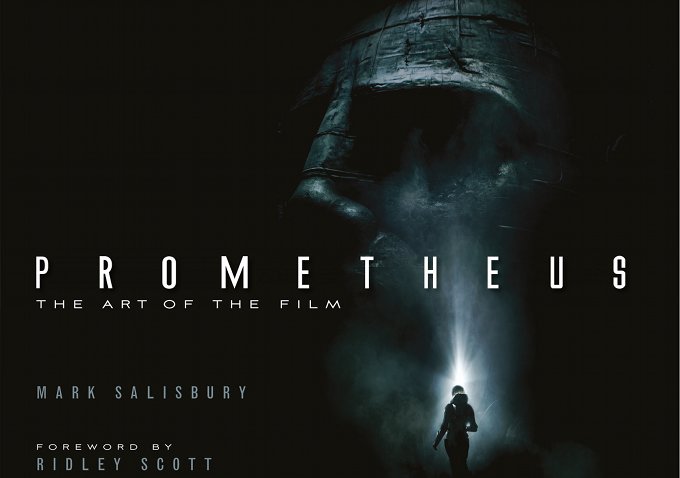 Judging by the comments here and here, everyone is a bit “Prometheus”-ed out at this point, even if, like me, you came down on the positive side. It’s easy to forget the film only opened in North America last Friday, so epic is the flow of post-viewing discourse. (“Prometheus”: The “Girls”/"Mad Men" of summer cinema.)
Judging by the comments here and here, everyone is a bit “Prometheus”-ed out at this point, even if, like me, you came down on the positive side. It’s easy to forget the film only opened in North America last Friday, so epic is the flow of post-viewing discourse. (“Prometheus”: The “Girls”/"Mad Men" of summer cinema.)
So what more can be said? Plenty. As Titan Books’ gorgeous, hardcover “Prometheus: The Art of the Film” makes evident, we’ve only hit the tip of the Nostromo in terms of understanding everything that’s visible, or hinted at, in Ridley Scott’s divisive sci-fi epic. With startling imagery and simple, unfussy text from author Mark Salisbury, the book offers something viewers have so far lacked: A complete overview of the film’s concept and design from the filmmakers themselves. And until the Blu-ray release, this is likely the closest we’ll get to a breakdown from Sir Ridley.
Like the film itself, the text demands a familiarity with Scott’s original “Alien”; we journey quickly from the project’s initial birth as “Untitled Alien Prequel” to the Luke Scott-helmed TED viral video, which, unsurprisingly, “was conceived and designed by Ridley Scott and Damon Lindelof.” We see storyboard art by the director himself — “Ridleygrams” as the book calls them — and move through the plot, beat by icky beat, to the unveiling of the climactic, Giger-y “offspring of the Trilobite’s impregnation of the Engineer, the Deacon.” (Scott’s explanation of the name is quite clever — think Catholicism.)
Perhaps most intriguingly, the book spells out some of the film’s most WTF? moments in the most direct detail we’ve seen yet. An example is the already controversial opening. While it’s not overly difficult to interpret its meaning in light of all that takes place over the 120 minutes that follow, seeing it spelled out in black and white is, at the very least, helpful: “A young Engineer drinks from a ceremonial cup, then begins to disintegrate, his remains blowing into the sea and, eventually, mankind itself.” This is a rather explicit explanation, at the very least.
We learn the cockamamie names for such elements as the holographic navigation system discovered by David (the orrery) and just what the inspirations were for the Engineers’ appearance (Michelangelo’s David, The Statue Of Liberty, and, ahem, Elvis Presley). In fact, the textual analysis is often more enticing than the admittedly stunning artwork. Even throwaway lines greatly add to one’s understanding of Scott’s modus operandi. Example: While it’s a bit confusing onscreen, Prometheus is most assuredly “not set on LV-426 (‘That’s another planet,’ confirms Scott).”
Interestingly, Titan has also rereleased 1979’s “Book of Alien,” a dated but fascinating behind-the-scenes look at Scott’s immortal original. In light of the discoveries in “Prometheus,” it is especially fascinating to read author Paul Scanlon and Michael Gross’s analysis of the Space Jockey: “While the Alien is a terrifying, nightmarish creature, the jockey — while certainly inhuman — is not. Sitting in repose in its doomed derelict ship, the jockey somehow appears to have been a benign creature. People involved in the film tend to agree on this. But they can’t explain why.”
The included unused art is also of interest, especially an apparently un-filmed (we’ll see about that when the extended cut arrives) end sequence in which the Deacon exits the lifeboat and seemingly makes its way to the downed ship. And production anecdotes certainly entertain, especially one that recalls one of the most infamous startling sequences: “When the Hammerpede attacks Millburn, his arm is broken. … Filming the scene, much like in ‘Alien’ where not every cast member knew what was about to happen with John Hurt and the chestburster, Scott didn’t tell Kate Dickie, who plays Ford, the ship’s doctor, everything. ‘Ridley had indicated something was going to happen, recalls [creature and special makeup effects supervisor Neal] Scanlon. ‘We had the Hammerpede on the end of a monofilament wire, loaded into a dummy of Milburn that was rolled over. As we pulled it out, it was clearly an enormous shock to her. The screams are real.”
Anecdotes are all well and good, but a truly strong book on film design must enhance the experience of re-watching (consider 2009’s “A.I. Artificial Intelligence: From Stanley Kubrick to Steven Spielberg: The Vision Behind the Film”). “Prometheus: The Art of the Film” certainly achieves that, and for those who still find themselves pondering this eccentric creation days after exiting the cinema, it might just be an essential read, even at 40 bucks. Of course, it leaves many, many questions unanswered: Are we really supposed to buy the “Jersey Shore”-esque Logan Marshall-Green as a wildly intelligent scientist? Why not cast an actual older person as Weyland, rather than saddling Guy Pearce with the worst old-aged make-up since Charles Foster Kane wandered Xanadu? A Stephen Stills reference? Really? But in the end, it does what a great visual analysis should — it makes us want to dive back into this world again.
So leave it to Ridley “King of Development” Scott to end the book with an even more obvious appeal for a sequel than the film itself did: “I thought ‘Prometheus’ was so enjoyable — returning to the world of science fiction was so fun — I’m thinking about what the hell I might do for a ‘Prometheus 2’ …”
"Prometheus: The Art Of The Film" is in bookstores now.
Images © 2012 Twentieth Century Fox Film Corporation. All Rights Reserved.

